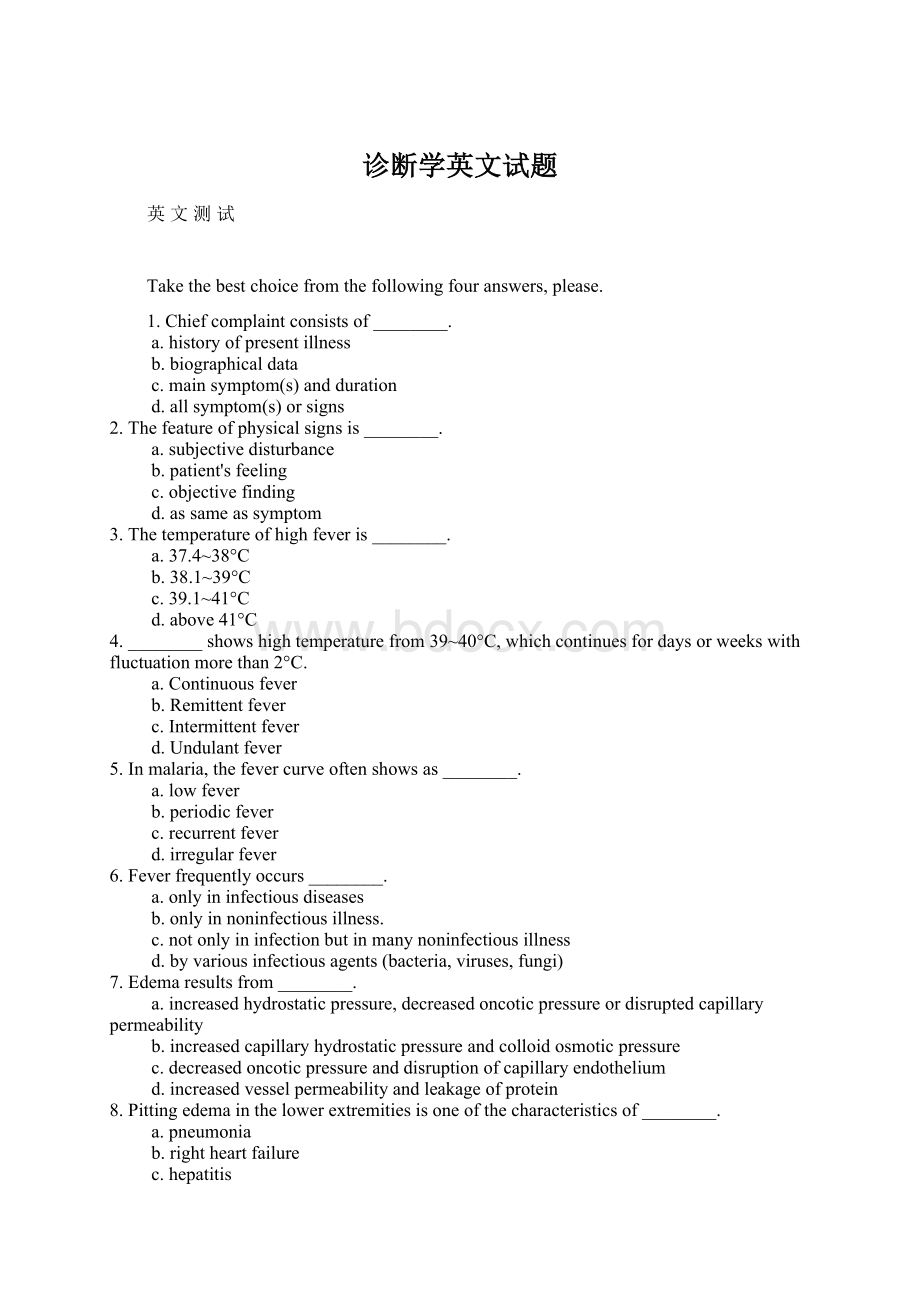诊断学英文试题.docx
《诊断学英文试题.docx》由会员分享,可在线阅读,更多相关《诊断学英文试题.docx(10页珍藏版)》请在冰豆网上搜索。

诊断学英文试题
英文测试
Takethebestchoicefromthefollowingfouranswers,please.
1.Chiefcomplaintconsistsof________.
a.historyofpresentillness
b.biographicaldata
c.mainsymptom(s)andduration
d.allsymptom(s)orsigns
2.Thefeatureofphysicalsignsis________.
a.subjectivedisturbance
b.patient'sfeeling
c.objectivefinding
d.assameassymptom
3.Thetemperatureofhighfeveris________.
a.37.4~38°C
b.38.1~39°C
c.39.1~41°C
d.above41°C
4.________showshightemperaturefrom39~40°C,whichcontinuesfordaysorweekswithfluctuationmorethan2°C.
a.Continuousfever
b.Remittentfever
c.Intermittentfever
d.Undulantfever
5.Inmalaria,thefevercurveoftenshowsas________.
a.lowfever
b.periodicfever
c.recurrentfever
d.irregularfever
6.Feverfrequentlyoccurs________.
a.onlyininfectiousdiseases
b.onlyinnoninfectiousillness.
c.notonlyininfectionbutinmanynoninfectiousillness
d.byvariousinfectiousagents(bacteria,viruses,fungi)
7.Edemaresultsfrom________.
a.increasedhydrostaticpressure,decreasedoncoticpressureordisruptedcapillary
permeability
b.increasedcapillaryhydrostaticpressureandcolloidosmoticpressure
c.decreasedoncoticpressureanddisruptionofcapillaryendothelium
d.increasedvesselpermeabilityandleakageofprotein
8.Pittingedemainthelowerextremitiesisoneofthecharacteristicsof________.
a.pneumonia
b.rightheartfailure
c.hepatitis
d.renaldiseases
9.Inspiratorydyspneaindicates________.
a.acutepulmonaryedema
b.cardiacasthma
c.obstructionofintrathoracicairways
d.largeairwayobstruction
10.________definitelyindicatesleftheartfailure.
a.asthma
b.shortbreath
c.keepingasitingposition
d.paroxysmalnocturnaldyspnea
11.Skeletallandmarksincludeallbut________.
a.intrasternalangle
b.ribs
c.spinousprocess
d.noneoftheabove
12.Accordingtothedivisionoflobesofthelung,allofthefollowingarecorrectexcept________.
a.thelowerlobeisindeedthedependentlobe
b.thelowerlobesaretheanteriorlobe
c.therightmiddlelobeiswedgedbetweentheupperandtheloweranteriorly.
d.Thedesignationofupperandlowerlobesofthelungisnotaltogethercorrect.
13.Chesttendernessisnotusuallyelicitedwhensufferingfrom________.
a.intercostalneuritis
b.pneumonia
c.ribfracture
d.cartilaginousinflammation
14.Apatienttendstobreathethroughpursedlips________.
a.bydoingso,herelievesahighintraluminalpressure
b.bydoingso,heremainsairwayscollapse
c.itshowsthepatienthavebeeninonsetofasthma
d.allofaboveareincorrect
15.Pleuralrubs________.
a.occurinlateacutepleurisywithmassiveeffusion
b.aremoredullinqualitythanronchi
c.areunaffectedbycough
d.areclosetotheearandlessenedbypressureofthestethoscope
16.Threedepressionsignreferstothedepressionin________.
a.thesuprasternalfossae
b.thesupraclavicularfossae
c.theintercostalspace
d.alloftheabove
17.Variationofrespiratoryrhythmincludes________.
a.Cheyne-Stokesrespiration
b.deep-fastrespiration
c.Kussmaul'srespiration
d.tachypnea
18.Vocalfremitusincreasesbecauseof________.
a.loudvoice
b.highpitch
c.thickchestwall
d.alloftheabove.
19.Decreasedorabsentvocalfremitusrarelyoccursin________.
a.emphysema
b.lungconsolidation
c.pneumothorax.
d.obstructiveatelectasis.
20.Allofnotesasfollowsarepercussionnotesexcept________.
a.fremitus
b.tympany
c.dullness
d.resonance
21.Hyperresonanceisnormallycausedover________.
a.pneumonia
b.pneumothorax
c.emphysema
d.pleuraleffusion
22.Normalpercussion________.
a.overtheupperanteriorismoreresonantthanthelowerone
b.onrightupperchestisdullerthanthatontheleft
c.onbackismoreresonantthanthatonfront
d.onleftlowerchestalongtheanterioraxillarylineisflatness
23.Thedownwardlowerlungmarginsoccurin________.
a.emphysema
b.atelectasis
c.peritonealeffusion
d.megalohepatia
24.Thecorrectmethodsofpercussionontheextentofdiaphragmaticexcursionareasfollowsbut________.
a.percussthelowerlungmarginswiththequietrespirationfirst
b.askthepatienttoexhaledeeplyandtoholdhisbreath
c.goonpercussingalongthescapularlinedownwarduntiltheresonancebecomesdull
d.thelaststepispercussingdownwardfromthehigherpointatthesamelineuntilthe
resonancebecomesdull
25.Decreaseddiaphragmaticexcursionsuggests________.
a.pulmonaryinflammation
b.severeeffusion
c.severepneumothorax
d.widepleuralthickness
26.Whentheauscultationbegins,________iswrong.
a.theexaminershouldinstructthepatienttobreathalittledeeperandfaster
b.thepatient'spositioncanbesittingorsleeping
c.sometimescoughisnecessary
d.comparisonisabsolutelynotneeded
27.Thevesicularbreathsoundischaracterizedininspiratoryphaseby________.
a.shorterduration
b.weakersounds
c.lowerpitch
d.alloftheaboveareincorrect
28.Bronchialbreathsoundisproducedby
a.theresultofairflowgoinginthebronchioles
b.theresultofairflowgoingoutthebronchioles
c.theturbulenceinthemainstemandbronchioles
d.theturbulenceinthevocalentrance,tracheaormainstem
29.Bronchovesicularbreathsoundisheardnormallyinalloffollowingregionsexcept________.
a.the3rdandthe4thintercostalspacesanteriorly
b.the5thandthe6thintercostalspacesposteriorly
c.the6thandthe7thintercostalspaceslaterally
d.allofabove
30.Decreasedorabsentvesicularbreathsoundsoccurin________.
a.acidosis
b.hypermetabolism
c.chronicbronchitis
d.allofabove.
31.Delayedexpiratorysoundssuggestsallbut________.
a.bronchitis
b.asthma
c.obstructiveemphysema
d.theupperairway'sblock.
32.Themoistrales________.
a.presentnormally
b.areproducedbybrokenbubblingofairthroughthicksecretion
c.areclassifiedintothecoarserales,mediumrales,finerales,andcrepitus
d.allofabovearecorrect
33.Characteristicsofmoistralesare
a.long
b.loud
c.apparentlyinbothendofrespiration
d.notdiminishedbycough.
34.Forrhonchi,________.
a.themechanismissimilartomoistrales
b.theyareapparentininspiration
c.sonorousrhonchiarecharacteristicofasthma
d.diffusedrhonchioftenoccurinbronchialasthma,chronicbronchitisorcardiac
asthma
35.Ifapatientshowsprotrusionofprecordium,itmayindicatethat________.
a.heishealthy
b.hesuffersfromorganiccardiacdisease
c.heisapatientwithcoronaryheartdisease
d.hesuffersfromarrhythmia
36.Adiffuseimpulsemeansthattheareaofapicalimpulseismorethan________cmindiameter.
a.2~2.5
b.2.5~3
c.3~3.5
d.3.5~4
37.Rightventricularenlargementcausesachangeofapicalbeatinpositiontowards.
a.left
b.right
c.bothleftandright
d.downwardandoutward
38.Intheleft3rdor4thparasternalarea,systolicthrillareoccasionallyfeltdueto________.
a.congenitallesionsoftheinterventricularseptum
b.pulmonaryvalvestenosis
c.mitralvalvestenosis
d.aorticvalveregurgitation
39.Thecardiacdullnessenlargedtowardstwosidesmayresultfrom________.
a.leftventricleenlarged
b.rightventricleenlarged
c.hydropericardium
d.emphysema
40.The2ndaorticareaislocatedin________.
a.the5thleftintercostalspace,1or2cmmedialtothemidclavicularline
b.the2ndleftintercostalspacejustlateraltothesternum
c.the3rdor4thleftintercostalspacelateraltothesternum
d.the2ndrightintercostalspacejustlateraltothesternum
41.Pulsedeficitoftenoccursin________.
a.tachycardia
b.bradycardia
c.trigeminalbeats
d.atrialfibrillation
42.Normally,itisinoldpersons________.
a.P2>A2
b.P2 c.P2=A2
d.noP2
43.ismostimportantindifferentiationbetweenS1andS2________.
a.LongerpausebetweenS1andS2
b.ThatS2isclearlyaudibleinthepulmonaryvalvearea
c.ThatS2ishigherinfrequencyandshorterindurationthanS1
d.ThatS1couldbeidentifiedbysynchronouspalpationoverradialartery
44.AloudS1maybeheardin________.
a.mitralstenosis
b.mitralregurgitation
c.aorticstenosis
d.aorticregurgitation
45.LouderS2inthe2ndrightintercostalspacejustlateraltothesternumisheardwith________.
a.damagedsemilunarvalve
b.hypertension
c.hyperthyroidism
d.pulmonaryarteryhypertension
46.In,thesplittingofS2isclearlyaudiblewithinspiration________.
a.CRBBB
b.atrial-septaldefect
c.completeleftbundlebranchblock
d.aorticvalvestenosis
47.ThatsplittingofS2isclearlyaudiblewithinspirationisreferedtoas________.
a.normalsplitting
b.fixedsplitting
c.paradoxicalsplitting
d.separatedsplitting
48.isusuallyheardinventricularfailure________.
a.Protodiastolicgallop
b.Presystolicgallop
c.Openingsnap
d.Pericardialknock
49.Theopeningsnapoccurs________.
a.duringthelaterphaseofventricularfilling
b.intheearlyphaseofsystole
c.inthemid-phaseofdiastole
d.so